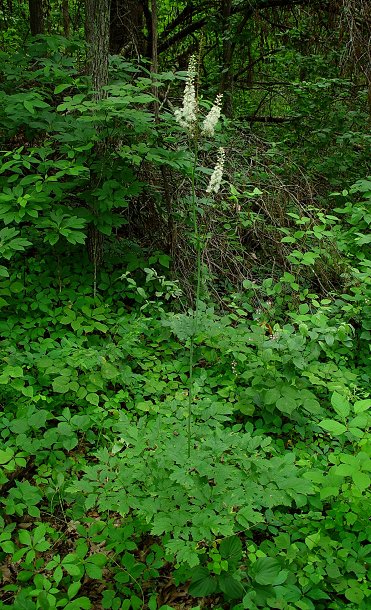Actaea racemosa L.
Black Cohosh

Native
CC = 7
CW = 5
MOC = 25
© DETenaglia
Actaea racemosa L.Black Cohosh | |
 |
Native CC = 7 CW = 5 MOC = 25 |
© DETenaglia |
|
Family - Ranunculaceae Habit - Rhizomatous perennial forb, sometimes with a woody base. Stems - Erect, to 2.5 m, glabrous, glaucous, green but often purple at the nodes.
Leaves - Basal and alternate, petiolate, 2 times pinnately compound, glabrous, to 1 m broad, the leaflets ovate to broadly lanceolate, toothed and irregularly sharply lobed, green adaxially, silvery-green abaxially, with a few hairs abaxially on the veins, the largest leaflets 5-10 cm long, 3-7 cm wide. Veins of leaflets impressed adaxially. Leaves of the flowering stem reduced to bracts.
Inflorescence - Panicles with 2 or 3 racemelike branches, 15-43 cm long. Axis of the inflorescence tomentoulose. Flower stalks 4-6 mm long, 0.2-0.5 mm wide, densely pubescent with soft contorted hairs, subtended by minute bracts.
Flowers - Actinomorphic, perfect. Sepals 3-5, greenish white, 2-6 mm long, plane or somewhat concave, not persistent at fruiting. Petals 4-10, white or cream-colored, 2-4 mm long, plane. Stamens numerous, showy, the anthers white or yellow. Staminodes absent. Pistils 1-8, each with 4 to numerous ovules. Stigma 0.5-1.0 mm wide.
Fruits - Follicles, 1 per flower stalk, 5-10 mm long, ovoid or ellipsoid. Seeds semicircular, smooth or ridged.
Flowering - June - July. Habitat - Mesic upland forests, often in rocky places, bases of bluffs, mostly on calcareous and cherty substrates. Origin - Native to the U.S. Lookalikes - None when flowering. Vegetatively resembles A. pachypoda. Other info. - This distinctive species can be found across much of the southern third of Missouri, and eastward from Missouri into the northeast and Canada. When in bloom, the plant is easy to ID in the field because of its big leaves and long inflorescences. The plant also has a foul odor, especially when in flower. Photographs taken at the Current River Conservation Area, Reynolds County, MO., 6-26-01, and at Big Spring Park, MO., 7-1-03 (DETenaglia); also at Johnson's Shut-Ins, Reynolds County, MO, 6-26-2015 and 10-1-2018 (SRTurner). |